
by Matt Lollar | Oct 8, 2019
Last week at the Panhandle Fruit and Vegetable Conference, Dr. Ali Sarkhosh presented on growing pomegranate in Florida. The pomegranate (Punica granatum) is native to central Asia. The fruit made its way to North America in the 16th century. Given their origin, it makes sense that fruit quality is best in regions with cool winters and hot, dry summers (Mediterranean climate). In the United States, the majority of pomegranates are grown in California. However, the University of Florida, with the help of Dr. Sarkhosh, is conducting research trials to find out which varieties do best in our state.
In the wild, pomegranate plants are dense, bushy shrubs growing between 6-12 feet tall with thorny branches. In the garden, they can be trained as small single trunk trees from 12-20 feet tall or as slightly shorter multi-trunk (3 to 5 trunks) trees. Pomegranate plants have beautiful flowers and can be utilized as ornamentals that also bear fruit. In fact, there are a number of varieties on the market for their aesthetics alone. Pomegranate leaves are glossy, dark green, and small. Blooms range from orange to red (about 2 inches in diameter) with crinkled petals and lots of stamens. The fruit can be yellow, deep red, or any color in between depending on variety. The fruit are round with a diameter from 2 to 5 inches.
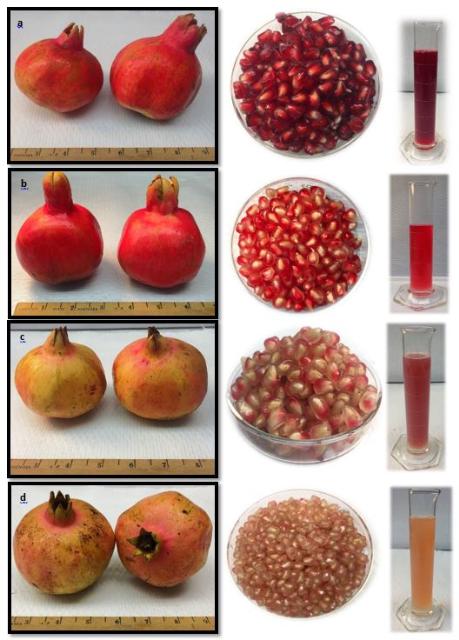
Fruit, aril, and juice characteristics of four pomegranate cultivars grown in Florida; fruit harvested in August 2018. a) ‘Vkusnyi’, b) ‘Crab’, c) ‘Mack Glass’, d) ‘Ever Sweet’. Photo Credit: Ali Sarkhosh, University of Florida/IFAS
A common commercial variety, ‘Wonderful’, is widely grown in California but does not perform well in Florida’s hot and humid climate. Cultivars that have performed well in Florida include: ‘Vkusnyi’; ‘Crab’; ‘Mack Glass’; and ‘Ever Sweet’. Pomegranates are adapted to many soil types from sands to clays, however yields are lower on sandy soils and fruit color is poor on clay soils. They produce best on well-drained soils with a pH range from 5.5 to 7.0. The plants should be irrigated every 7 to 10 days if a significant rain event doesn’t occur. Flavor and fruit quality are increased when irrigation is gradually reduced during fruit maturation. Pomegranates are tolerant of some flooding, but sudden changes to irrigation amounts or timing may cause fruit to split.
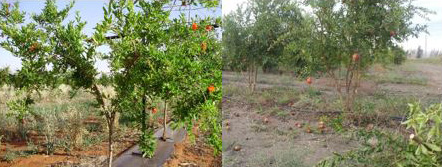
Two pomegranate training systems: single trunk on the left and multi-trunk on the right. Photo Credit: Ali Sarkhosh, University of Florida/IFAS
Pomegranates establish best when planted in late winter or early spring (February – March). If you plan to grow them as a hedge (shrub form), space plants 6 to 9 feet apart to allow for suckers to fill the void between plants. If you plan to plant a single tree or a few trees then space the plants at least 15 feet apart. If a tree form is desired, then suckers will need to be removed frequently. Some fruit will need to be thinned each year to reduce the chances of branches breaking from heavy fruit weight.
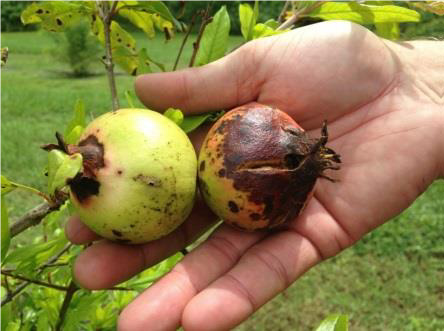
Anthracnose caused by Colletotrichum sp. to pomegranate fruit. Photo Credit: Gary Vallad, University of Florida/IFAS
Anthracnose is the most common disease of pomegranates. Symptoms include small, circular, reddish-brown spots (0.25 inch diameter) on leaves, stems, flowers, and fruit. Copper fungicide applications can greatly reduce disease damage. Common insects include scales and mites. Sulfur dust can be used for mite control and horticultural oil can be used to control scales.

by Mary Salinas | Jul 11, 2019
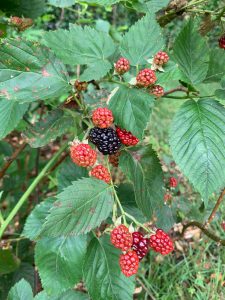
Ripening thornless blackberries. Photo credit: Mary Salinas, UF/IFAS Extension.
To everyone’s delight, the blackberries are ripening in the Santa Rosa County Extension demonstration garden. The blackberry patch is a reliable perennial that continues to provide fresh berries year after year. Before you decide against them because you don’t want a thorny and painful hazard in your landscape, remember that there are thornless blackberry cultivars with fruit just as tasty as the old-fashioned thorny blackberry varieties. However, it is important to take care and make sure that the variety or cultivar you choose is adapted to our Florida climate and chill hours.
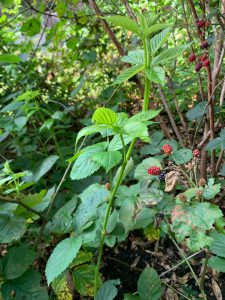
Blackberries bloom and produce fruit on last year’s canes. This year’s growth (the bright green shoot in the front center) will produce next year. Photo credit: Mary Salinas, UF/IFAS Extension.
You can choose a blackberry variety from your local nursery or propagate some plants from a favorite blackberry grown by a friend or neighbor (with permission, of course). Methods of propagation include stem cuttings, root cuttings, tip layering and removing the suckers that arise from the roots.
Plant when the weather is cooler in winter and choose a sunny spot with good soil. Frequent irrigation is crucial during the establishment period and when the fruit is produced. Weed control with organic or plastic mulches is also important to the success of your blackberry patch.
For more information on blackberry cultivars, propagation and growing success please see the University of Florida publication The Blackberry.
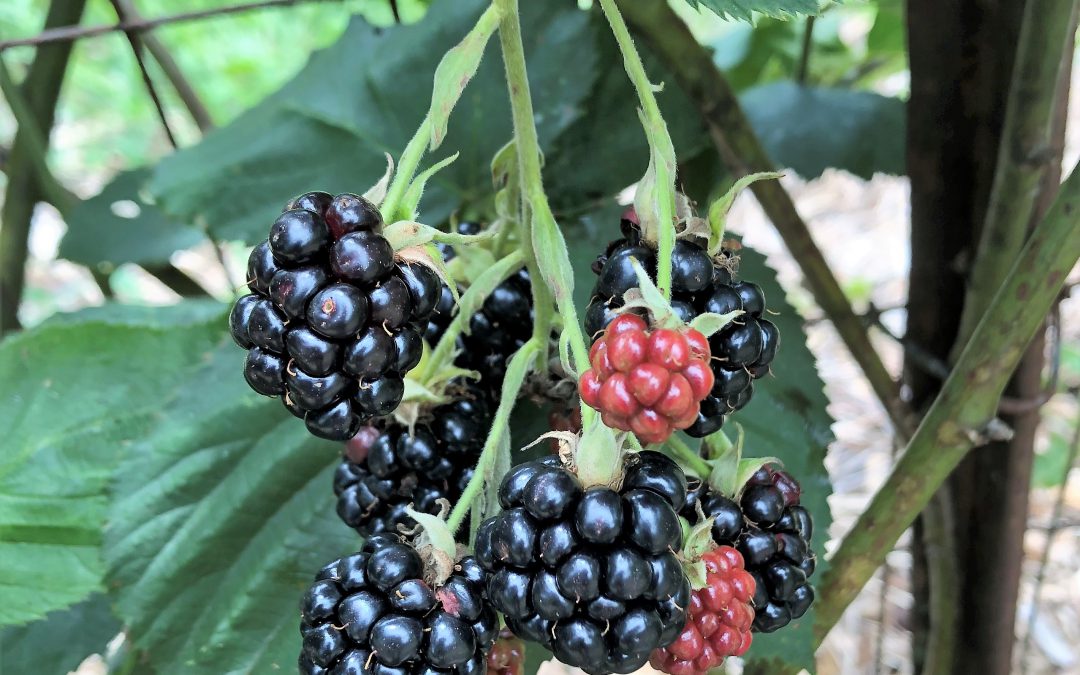
by Molly Jameson | Jun 25, 2019

Although blackberries are well adapted to North Florida, many different biotic and abiotic factors can impact fruit production. Photo by Molly Jameson.
Diagnosing Abiotic Blackberry Fruit Disorders
Whether it be wild blackberries you’ve foraged or a prized cultured variety you’ve oh-so-carefully sustained, we are now in prime blackberry season, and there are many sweet, tangy delectable fruits to be eaten.
Blackberry bushes are well adapted to the Florida Panhandle and the plants can be found growing all over – along roadways, in ditches, throughout open fields, and also within forests.
Although wild blackberries and domesticated cultivars thrive in our climate, there is a wide range of factors that could affect blackberry fruiting. When diagnosing plant problems, we tend to blame insects and diseases, but there are many abiotic (non-living) factors that could negatively impact blackberry fruit production. If your blackberry drupelets (the small subdivisions that comprise a blackberry fruit) are compromised, you may be experiencing one or more of the following abiotic blackberry disorders.
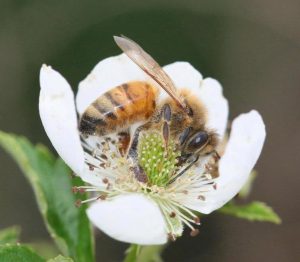
Although blackberries can self-pollinate, insect pollination is critical for forming the best blackberries. Photo by Johnny N. Dell, Bugwood.org.
Poor Pollination. Blackberries, strangely enough, are not true berries botanically. True berries only have one ovary per flower (such as bananas, watermelons, and avocados!). Each blackberry flower contains over 100 female flower parts, called pistils, that contain ovaries. To form a fully sized blackberry with many drupelets, at least 75% of the ovaries need to be pollinated. While blackberries can self-pollinate, pollinator insects, such as bees, are very important to ensure adequate drupelet formation. When weather conditions are overly cloudy and rainy, bees are less active. If this coincides with blackberry flowering, you may end up with some blackberries that are nearly drupe-less.
White Drupe. If you notice patches of white and brown drupelets on your most sun-exposed canes, you might have white drupe disorder. When humidity drops and temperature heats up, solar radiation contacting your berries is more powerful, as there is less moisture in the air to deflect the intense heat. Berries that are not protected by leaf coverage, and those on trellises oriented for maximum sun exposure, are most vulnerable to white drupe damage.
Sunscald. Often associated with white drupe, sunscald is most common when temperatures are extreme. Daytime highs in the Florida Panhandle in June and July regularly reach 90°F, if not higher. At these times, fruit exposed to the sun can be hotter than the air temperature around them, which essentially cooks the fruit. As I suspect you’d prefer to cook your fruit after harvest in preparation for blackberry pie, orient your trellis so it gets shade relief during the hottest part of the day and harvest often.
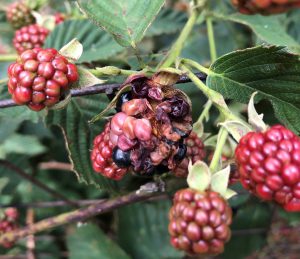
Diagnosing a blackberry issue can be challenging, as there can be more than one culprit impacting the fruit. Photo by Molly Jameson.
Red Cell Regression. One of the not-so-well understood abiotic blackberry disorders is red cell regression, or red drupelet disorder. If you’ve ever harvested blackberry fruit and stored them in the refrigerator for later munching, you may think your eyes are deceiving you when you discover your fruit doesn’t appear as ripe as when you picked it. This regression in color is linked to rapid temperature change, but rest assured, it does not affect the sugar content of the fruit. There are a few things you can do if you think this is affecting your berries, such as harvesting in the morning when the berries are still cool, harvesting when the sky is overcast, or shading your berries pre-harvest. You can also try to cool your berries in stages, perhaps moving from the field, to shade, to A/C, and then to the fridge.
Beyond abiotic stresses, blackberries can also suffer from insect, pest, and disease damage, such as from stink bugs, beetles, mites, birds, anthracnose, leaf rust, crown gall, and beyond. For domesticated blueberry bushes, proper cultivar selection, site selection, planting technique, fertilization, irrigation, propagation, and cane training is important and will allow the plants to grow healthy to defend themselves against any abiotic or biotic nuisance that comes their way.
For more information about growing blackberries, check out the EDIS publication, The Blackberry (https://edis.ifas.ufl.edu/hs104).
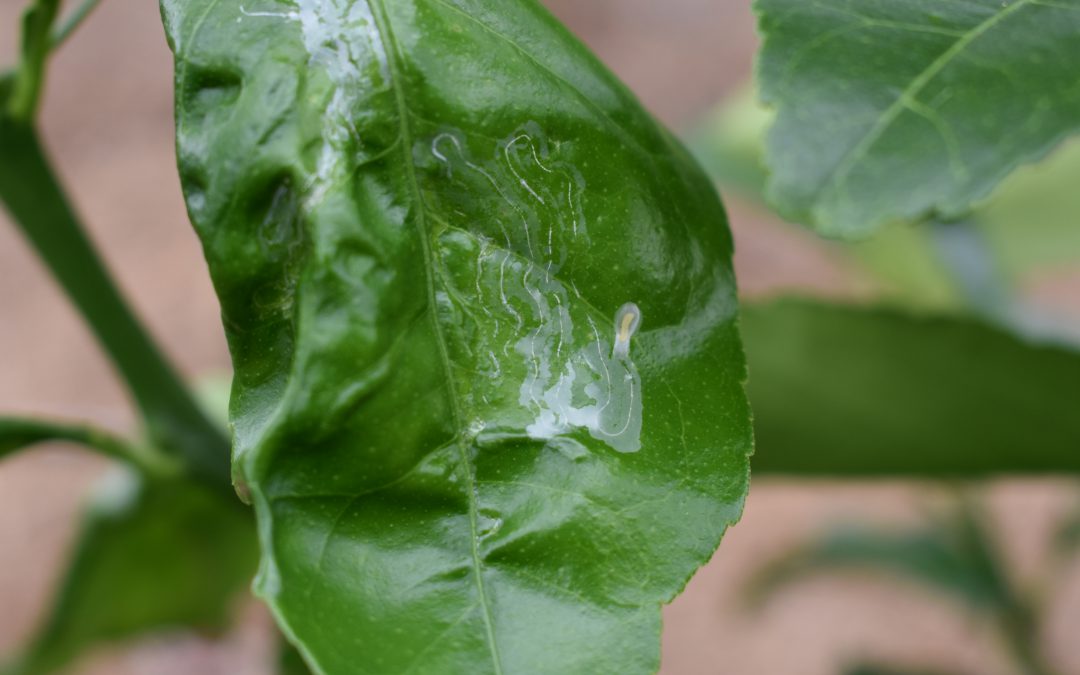
by Danielle S. Williams | May 20, 2019
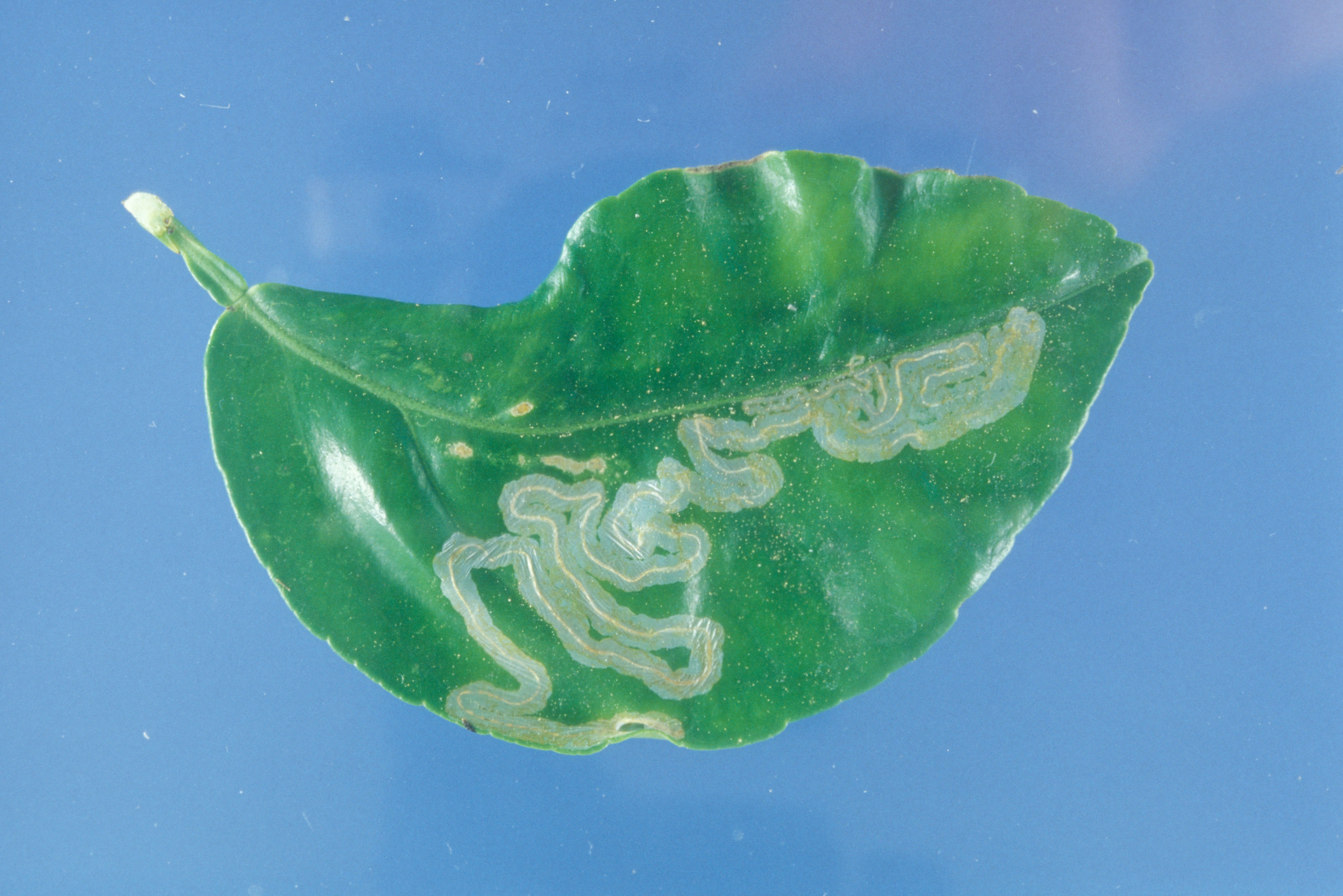
Citrus leafminer injury. Photo: James Castner
Spring is in full swing and citrus trees have begun actively flushing. With the new flush comes an array of insect pests. One of the most common being the citrus leafminer. The citrus leafminer is a small white moth, about 2.4 mm in length. It is more easily detected during its larval stage by the serpentine larval mines it produces on the underside of citrus leaves.
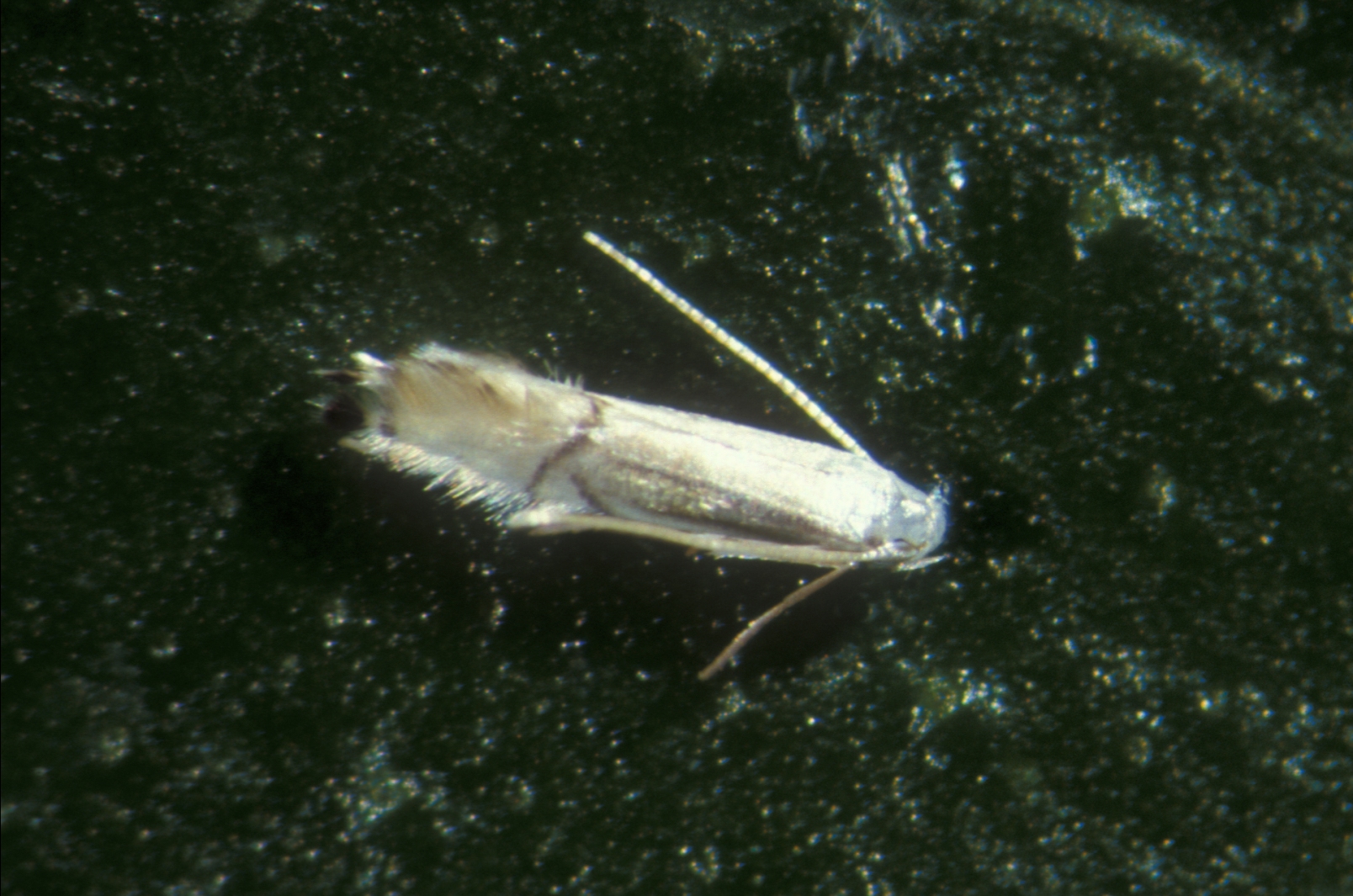
Citrus leafminer adult. Photo: James Castner
The larvae of the citrus leafminer feed on the new growth or flush of citrus causing serpentine mines to form under the leaf cuticle. This can result in leaf curling and distortion. Citrus leafminer injury to foliage can stunt the growth of young trees and in areas where the citrus canker pathogen is present, provide an opening for infection.

Distortion and leaf curling caused by citrus leafminer. Photo: Danielle Sprague
The term ‘flush’ is commonly used to describe the new foliar growth between bud break and shoot expansion. Citrus trees usually have several flushes per year, depending upon cultivar, climate and crop load. Generally, most citrus cultivars in our area have around three flushes. The main flush is the spring flush in late winter/early spring. Following that, two additional flushes occur around the end of June and late September.
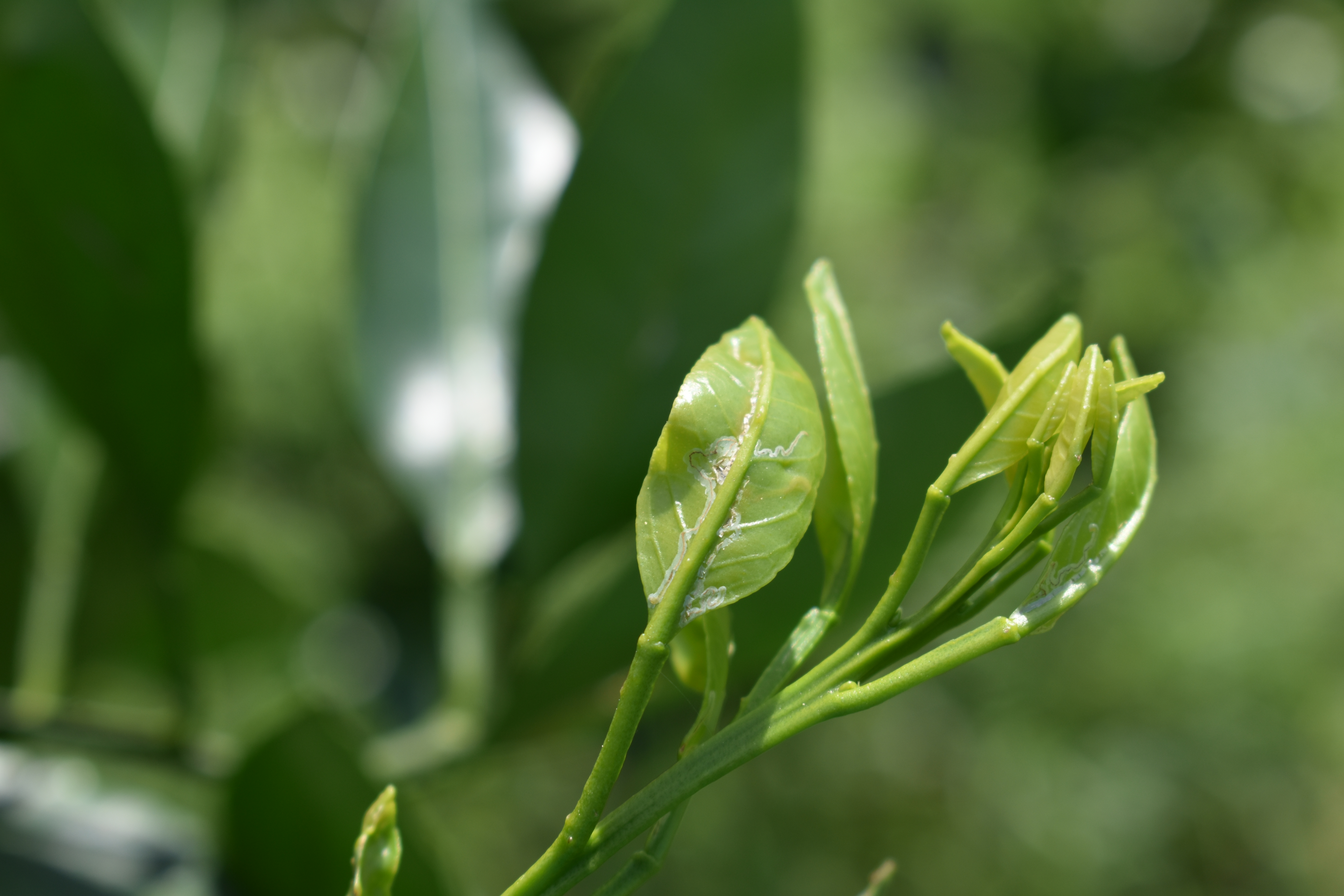
Citrus leafminer on young flush. Photo: Danielle Sprague
Adult leafminers require the new citrus flush for development. Eggs are laid within the flush. After two to ten days, the larvae emerge and feed causing the mines to occur. Larvae are protected within the leaf and therefore difficult to control. Pupation occurs within the leaf mine and takes anywhere from six to 22 days, depending upon temperature. Adults emerge around dawn and are most active in the morning and evening. In Florida, one generation of citrus leafminer is produced about every three weeks but populations increase when citrus trees are flushing.
In Florida, several natural enemies assist with reducing citrus leafminer populations. Studies have shown that predation from natural enemies can reduce leafminer populations by 90%. Primary predators of citrus leafminers include ants, lacewings and spiders. A parasitic wasp, Ageniaspis citricola was introduced into Florida and has become established. The parasitic wasp attacks the immature stages of citrus leafminer. Ageniaspis citricola can be requested and obtained for free from the Florida Department of Agriculture and Consumer Services (FDACS). Because it is a specialized parasitoid of the citrus leafminer larval stage, it should be released only when mines start to become visible on flush.
Citrus leafminer can be difficult to control with insecticides due to the fact that they are within the leaf and protected. Applications of insecticides require proper timing and may require repeat applications. For a full list of insecticides, contact your local Extension Office.
For more information on citrus leafminer, use the links to the following publications:
Citrus Leafminer, Phyllocnistis citrella Stainton (Insecta: Lepidoptera: Phyllocnistinae)
Citrus Leafminer Control – UGA

by Matt Lollar | Apr 9, 2019
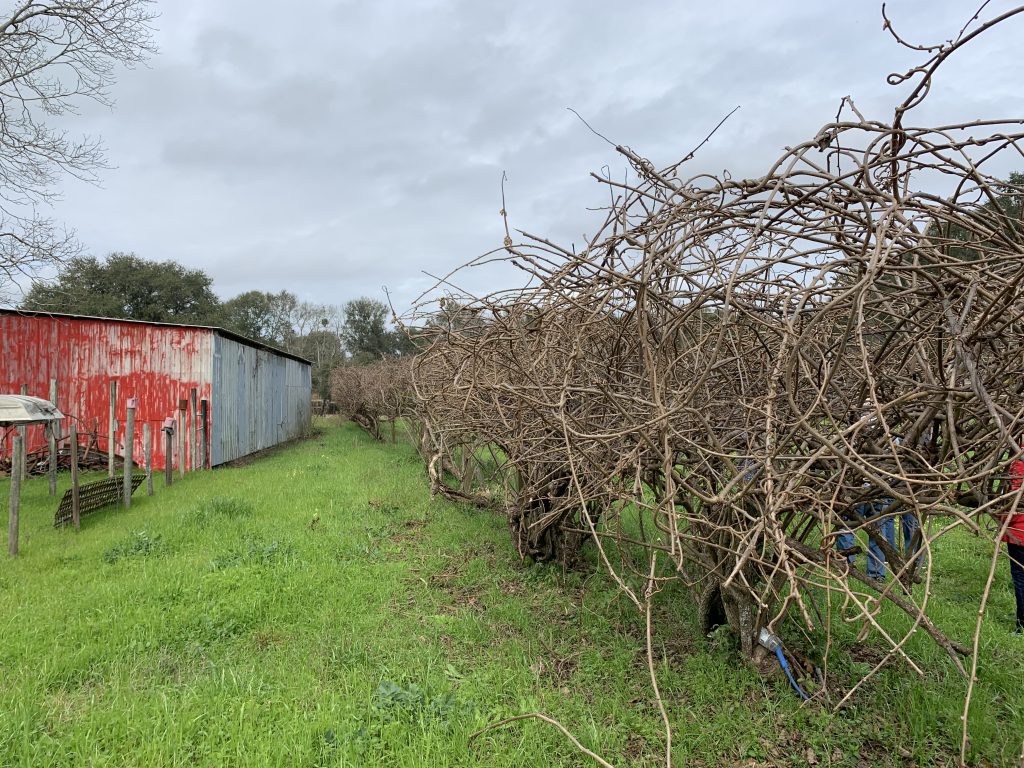
Twisted and tangled kiwifruit plants in a North Florida orchard. Photo Credit: Matt Lollar, University of Florida/IFAS Extension – Santa Rosa County
When we think of kiwis, we think of fuzzy, slightly tart, egg-shaped fruits from somewhere in the Southern Hemisphere. However, there is a species (Actinidia chinensis) of kiwi with smooth skin, sweet taste, and golden color.
Commonly available cultivars of this species are ‘AU Golden Dragon’ and ‘AU Golden Sunshine’. Most years, kiwis won’t produce much of a crop in North Florida because they won’t receive enough chill hours, but they might be fun to try for the adventurous gardener.
- Site Selection – Kiwis perform best in well-drained soils with a neutral pH (around 7.0). High winds may cause canes to break and scar fruit, so a windbreak is recommended or they can be planted near a structure.
- Irrigation – Kiwis need a lot of water during the summer. This is partly due the their large leaves that transpire rapidly because of surface area. Newly planted kiwis should be watered deeply at least once a week.
- Fertilization – Fertilize kiwis three times a year (January, April, and June). Do not apply fertilizer after the month of July to reduce the incidence of cold injury in the winter.
- Insects and Diseases – The most common insects of kiwis are mites and scales. To reduce the incidence of disease, plant kiwis at least 15 feet apart and train on a trellis.
- Training – A T-bar trellis, similar to the system used to train grape vines, or a pergola should be used to provide support for the plants. Once the plants are established (2 to 3 years after planting), about a third of the vines should be removed each year.

An illustration of a T-bar trellis system. University of Georgia Extension
Kiwis are wind- and insect-pollinated. Good growing conditions and insect pollination help increase fruit size. Male and female plants are required for good fruit yields. At least one male (pollen producing) plant should be planted for every four female (fruit producing) plants.
Kiwi plants will soon be planted for evaluation at the West Florida Research and Education Center in Jay, FL. Please stay tuned for future data! For more information on growing kiwis in the Southeast, please visit these webpages:
Kiwifruit Production Guide
Bringing Home the Gold – Auburn horticulture alum gets kiwifruit orchard off the ground in Reeltown

by Matthew Orwat | Apr 9, 2019
Citrus growers from across the Florida Panhandle, as well as southern Georgia and Alabama are invited to attend the 2019 Citrus Health Forum. The workshop will be held at the UF/IFAS North Florida Research and Education Center in Quincy (155 Research Road, Quincy, FL). Registration begins at 8:30 AM EST with the meeting starting at 9:00 AM and concluding at 3:00 PM. The workshop registration fee is $10 and includes refreshments and lunch.
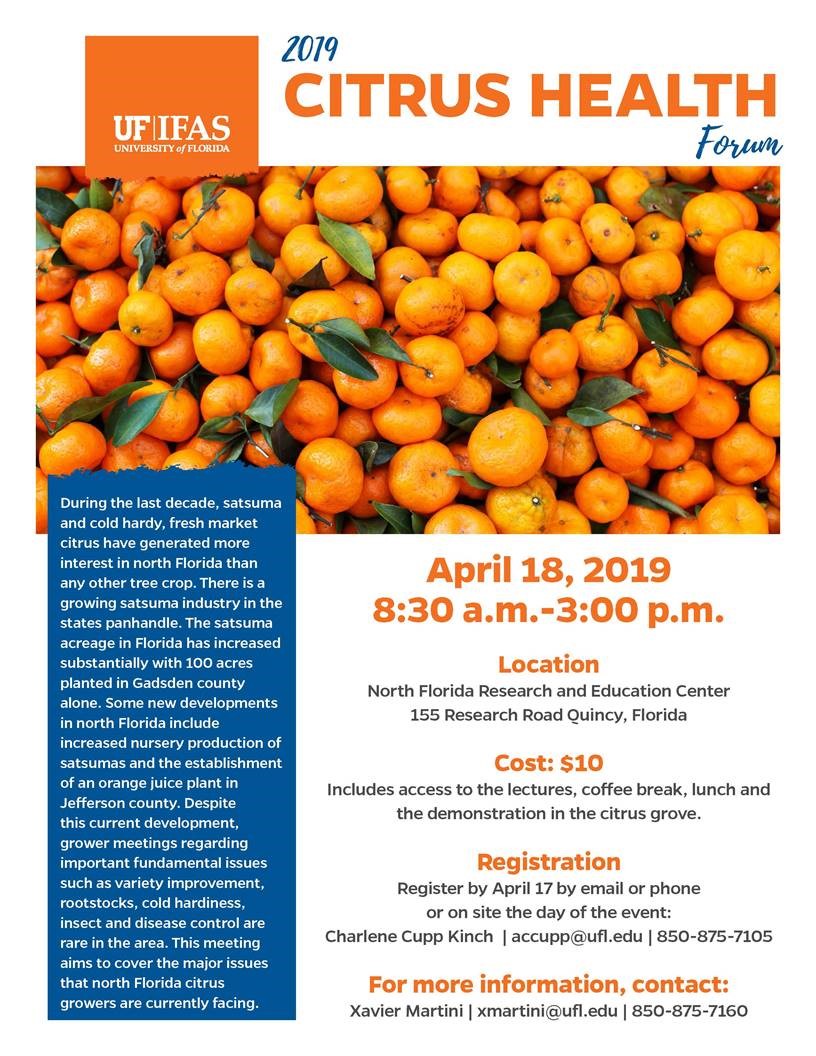
AGENDA:
A.M (all times Eastern)
8:30 Registration
9:00 Welcome – Dr. Glen Aiken, UF/IFAS NFREC-Center Director
9:15 Cold Hardy Citrus Varieties for North Florida – Dr. Pete Andersen, UF/IFAS NFREC Horticulture
9:45 Arthropod Pests of Citrus – Dr. Lauren Diepenbrock, UF/IFAS CREC Entomology
10:15 Unexpected Diaprepes abbreviatus Infestations in North Florida – Dr. Russ Mizell, UF/IFAS NFREC Entomology
10:30 Break
10:45 Citrus Canker, Alternaria and Scab Diseases of Citrus – Dr. Megan M. Dewdney, UF/IFAS CREC Plant Pathology
11:15 Phytophthora Management and HLB Basics – Dr. Evan G. Johnson, UF/IFAS CREC Plant Pathology
11:45 Lunch
12:45 Detection of HLB by Canines – Dr. Tim R. Gottwald, USDA Plant Pathology
1:10 Asian Citrus Psyllid Distribution and Management in North Florida – Xavier Martini, UF/IFAS NFREC Entomology
1:35 Enterprise Budgets for Satsuma in North Florida – Dr. Kevin R. Athearn, UF/IFAS Economist
2:00 Detection of HLB by Canines: Field Demonstration – Bill Moraitis, F1K9
To register, please contact Charlene at accupp@ufl.edu or by phone at 850-875-7105. For more information on the meeting, or to help sponsor the event, contact Xavier Martini at xmartini@ufl.edu or 850-875-7160.





















